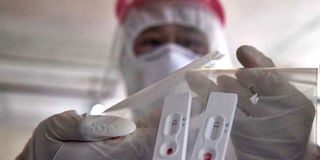Premium
To flatten the curve, we must do more testing

A medic displays a new rapid testing kit for Covid-19. PHOTO | LILIAN Lillian SUWANRUMPHA | AFP
What you need to know:
South Korea’s testing of more people at the beginning, along with measures like social distancing and handwashing, helped the country flatten the curve rather fast.
In contrast, the US was slow to react and it has the highest number of Covid-19 deaths.
We can only flatten the curve through widespread testing combined with effective contact tracing and quarantine and or isolation.
Last month, World Health Organisation director-general Tedros Adhanom Ghebreyesus said: “We have a simple message for all countries: test, test, test.”
Dr Tedros said there has not been an urgent enough escalation in testing, isolation and contact tracing, which is the "backbone" of the global response to the coronavirus pandemic.
He said it is not possible to "fight a fire blindfolded. And we cannot stop this pandemic if we don’t know who is infected”.
By the time Dr Tedros was issuing the test plea, South Korea had spent weeks doing just that. It had quickly developed the capability to test an average of 12,000 people – and sometimes as many as 20,000 – per day at hundreds of drive-through and walk-in testing centres.
The mobile centres conducted the tests free of charge within 10 minutes and the results were sent to people’s phones within 24 hours. By mid-March, more than 270,000 people had been tested.
South Korea’s formula to test and trace contacts of those infected by the virus enabled the country to quickly flatten the curve.
To put things into perceptive, perhaps we can look at the United States’ response to the pandemic and just how different the country’s outcomes have turned out.
The US and South Korea announced their first coronavirus cases on the same day. What is interesting, however, is that the US was for very long woefully behind South Korea's rate of testing per capita, even though the US has six times the population of South Korea.

South Korea’s testing of more people at the beginning, along with measures like social distancing and handwashing, helped the country flatten the curve rather fast. In contrast, the US was slow to react and it has the highest number of Covid-19 deaths.
South Korea’s testing level and supported isolation prove how effectively we can trace people’s contacts, warn the contacts about their exposure and need for testing, test them and isolate those who have Covid-19.
While countries have taken different approaches to handling Covid-19, Kenya had announced plans similar to South Korea’s.
In its projections, the Kenyan government said Kenya would have about 10,000 cases by the end of this month. This modelling was done using various parameters, one being testing of between 200,000 and 300,000 people by the end of this month.
Kenya has announced widespread testing or targeted mass testing. However, the country has tested less than 20,000 people and the highest number of tests done in a single day so far is 1,790 – on April 19.
The government’s initial plan to test between 200,000 and 300,000 people by the end of April has now been postponed. The government now says it will test 250,000 people by the end of June.
Delayed widespread testing is a cause for concern for many, especially since widespread testing can provide a better picture of the spread of Covid-19.
We cannot rely on collective social distancing alone to tide us over until a vaccine is available. We can only flatten the curve through widespread testing combined with effective contact tracing and quarantine and or isolation.





